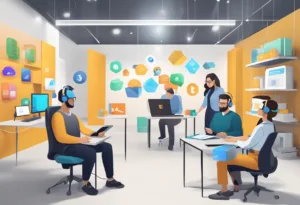Augmented reality (AR) is a technology that overlays digital information onto the physical world, creating an interactive and immersive experience. While AR was initially popularized in the gaming industry, it has now found its way into various industries, including retail, healthcare, education, and advertising. Companies that use augmented reality can leverage this technology to enhance customer engagement, improve operational efficiency, and drive revenue growth.
The rise of augmented reality in business has been driven by the increasing availability of AR technologies and platforms. Major players in the AR space, such as Google, Apple, and Microsoft, have invested heavily in developing AR tools and platforms that make it easier for businesses to create AR experiences. These platforms include ARKit, ARCore, and HoloLens, among others, which enable businesses to create AR experiences that are accessible to a wider audience.
AR applications across industries are diverse, ranging from product visualization and training to marketing and advertising. For instance, retailers can use AR to create virtual try-on experiences that allow customers to see how a product would look on them before making a purchase. In healthcare, AR can be used to train medical professionals and simulate surgical procedures. In advertising, AR can be used to create interactive and engaging campaigns that capture the attention of customers.
Key Takeaways
- Augmented reality is a technology that overlays digital information onto the physical world, creating an interactive and immersive experience.
- The rise of augmented reality in business has been driven by the increasing availability of AR technologies and platforms.
- AR applications across industries are diverse, ranging from product visualization and training to marketing and advertising.
The Rise of Augmented Reality in Business
Augmented Reality (AR) is a technology that overlays digital information on the real world. AR technology has been around for a while, but it has only recently gained traction in the enterprise world. In this section, we will discuss the rise of AR in business and how it is being used in various industries.
Enterprise Adoption of AR
The AR market is expected to grow rapidly in the coming years. According to a report by MarketsandMarkets, the AR market is expected to reach $61.39 billion by 2023. This growth is being driven by the adoption of AR in various industries, including enterprise.
Enterprise companies are using AR to improve productivity, reduce costs, and enhance customer experiences. For example, companies are using AR to train employees, visualize complex data, and improve collaboration. AR is also being used to create immersive experiences for customers, such as virtual try-ons in retail.
Retail and E-Commerce Innovations
AR is transforming the retail and e-commerce industries. Companies are using AR to create interactive experiences for customers, such as virtual try-ons and product visualizations. This technology is helping customers make informed purchasing decisions and enhancing their overall shopping experience.
AR is also being used to improve supply chain management. For example, companies are using AR to track inventory, optimize warehouse layouts, and improve shipping logistics. This technology is helping companies reduce costs and improve efficiency.
Manufacturing Efficiency with AR
AR is also being used in the manufacturing industry to improve efficiency and reduce costs. Companies are using AR to visualize complex data, train employees, and improve collaboration. AR is also being used to create immersive experiences for customers, such as virtual tours of factories.
AR is helping companies reduce downtime, improve quality control, and optimize supply chain management. For example, companies are using AR to reduce assembly time, improve maintenance processes, and optimize warehouse layouts. AR is also being used to create digital twins of factories, which can be used to simulate and optimize production processes.
AR is transforming the way businesses operate. Companies are using AR to improve productivity, reduce costs, and enhance customer experiences. With the AR market expected to grow rapidly in the coming years, it is clear that this technology will continue to play a significant role in the future of business.
10 Companies That Use Augmented Reality

- Nike
- IKEA
- Sephora
- L’Oréal
- Pepsi
- BMW
- Disney
- LEGO
- Zara
- Amazon
Nike
Nike uses AR to enhance the customer shopping experience, particularly in their SNKRS app. Customers can use their smartphone camera to visualize how different sneaker models would look on their feet. This allows for a ‘try before you buy’ experience directly from the user’s mobile device. Nike also uses AR for exclusive product launches and engaging marketing campaigns, providing a unique and interactive way for fans to connect with the brand.
IKEA
IKEA’s AR application, IKEA Place, allows customers to visualize how furniture and decor items will look and fit in their own homes before making a purchase. Users can browse through IKEA’s catalog, select products, and use their smartphone or tablet to place life-sized 3D models of the furniture in their space. This helps customers make more informed decisions and reduces the likelihood of returns due to size or style mismatches.
Sephora
Sephora’s Virtual Artist app uses AR technology to allow customers to try on makeup virtually. Users can test different products, shades, and styles using their smartphone’s camera to see how the makeup would look on their own face. This interactive experience provides a personalized and convenient way for customers to experiment with beauty products from the comfort of their home.
L’Oréal
L’Oréal has embraced AR across several of its brands with the aim of providing virtual makeup and hair color try-ons. Through their apps, users can see how different products will look on them, enabling a personalized beauty experience. L’Oréal’s AR efforts help to drive online sales and enhance customer satisfaction by allowing users to explore and find the right products without the need for physical testing.
Pepsi
Pepsi has used AR for marketing campaigns to create memorable and engaging experiences for consumers. For example, they’ve transformed bus shelters into interactive AR experiences, where users witness seemingly real-life scenarios, like a giant robot walking through the street or a tiger on the loose. These innovative campaigns attract attention and create buzz on social media.
BMW
BMW uses AR for both marketing and customer service. Potential customers can use AR to visualize how a car would look in different colors and with different features. BMW also offers AR experiences that allow users to explore the features and design of their vehicles in detail. AR is used to assist technicians with repairs and maintenance, overlaying digital information onto the physical car parts.
Disney
Disney has incorporated AR into various aspects of their entertainment offerings. From AR games and storybooks that bring characters to life to interactive experiences in their theme parks, Disney uses AR to enhance storytelling and create magical experiences for visitors and fans, adding an extra layer of engagement to their already immersive worlds.
LEGO
LEGO has introduced AR to add a digital layer to the physical play experience. With the LEGO AR-Studio app, children can see their LEGO creations come to life through interactive scenarios that combine the digital and physical worlds. This not only adds value to the traditional LEGO sets but also keeps the brand relevant in the age of digital play.
Zara
Zara has experimented with AR in its stores to engage customers and offer a unique shopping experience. Shoppers can point their smartphones at certain store displays or shop windows to see models come to life wearing Zara clothing. This allows customers to see the clothes in action and provides a dynamic way to showcase their latest collections.
Amazon
Amazon has integrated AR into its shopping app with the feature AR View, allowing customers to visualize how thousands of products, from furniture to electronics, will look like in their own homes. This feature helps customers make better purchasing decisions by providing a sense of scale and design compatibility, which is particularly useful for larger items that require more consideration.
Key AR Technologies and Platforms

Mobile AR Solutions
Mobile AR solutions are becoming increasingly popular with the advent of smartphones and tablets. Augmented reality technology has been integrated into mobile devices, enabling users to experience AR applications on the go. The two most popular mobile AR platforms are ARKit and ARCore, developed by Apple and Google, respectively. These platforms offer developers the tools to create AR experiences for iOS and Android devices.
AR apps have been developed for various purposes, including gaming, education, and marketing. For instance, the popular Pokemon Go app was developed using AR technology, allowing users to catch virtual Pokemon in the real world. Educational apps like Anatomy 4D use AR to provide a 3D view of the human anatomy.
AR Headsets and Glasses
AR headsets and glasses are wearable devices that allow users to experience augmented reality hands-free. The most popular AR headset is the Microsoft HoloLens, which is used for enterprise applications such as remote assistance and training. The HoloLens uses a combination of sensors, cameras, and holographic displays to overlay digital content onto the real world.
Another popular AR headset is the Magic Leap One, which uses spatial computing technology to create realistic 3D objects that can be interacted with in the real world. The Magic Leap One is used for a variety of applications, including gaming, entertainment, and productivity.
Development Platforms for AR
Developers can use various platforms to create AR applications, including Unity and Vuforia. Unity is a popular game development platform that has been adapted for AR development. Developers can use Unity to create AR experiences for multiple platforms, including mobile devices, AR headsets, and smart glasses.
Vuforia is another popular AR development platform that offers a range of tools for creating AR applications. Vuforia provides developers with the ability to track objects and images, recognize text, and create immersive AR experiences.
AR technology is rapidly evolving, with a growing number of companies developing AR solutions for various purposes. From mobile AR apps to AR headsets and development platforms, there are many ways to experience augmented reality.
Major Players in the AR Space

Augmented reality (AR) is the technology that overlays digital information onto the physical world. It has been gaining popularity in recent years, and many companies have been investing in this technology to enhance user experiences. In this section, we will discuss the major players in the AR space.
Tech Giants Leading AR
Apple, Microsoft, Google, and Samsung are some of the biggest tech giants that are leading the AR space. Apple’s ARKit and Google’s ARCore are two of the most popular AR development platforms. Microsoft’s HoloLens and Samsung’s Gear VR are some of the most popular AR headsets available on the market. These companies have been investing heavily in AR technology, and they have the resources and expertise to develop cutting-edge AR products.
Innovative AR Companies
Meta, Magic Leap, and VironIT are some of the most innovative AR companies in the market. Meta’s Meta 2 headset provides a high-quality AR experience, while Magic Leap’s Magic Leap One is a lightweight AR headset that provides a seamless AR experience. VironIT is a software development company that specializes in AR and VR development. These companies are pushing the boundaries of AR technology and are developing products that are changing the way we interact with the world.
Startups Shaping the Future of AR
Snap and Niantic are two startups that are shaping the future of AR. Snap’s Snapchat app uses AR to provide users with fun filters and lenses, while Niantic’s Pokemon Go game uses AR to create an immersive gaming experience. These companies have been successful in using AR to enhance user experiences, and they are paving the way for other startups to enter the AR space.
The AR space is rapidly evolving, and there are many companies that are investing in this technology to provide users with unique experiences. Tech giants like Apple, Microsoft, Google, and Samsung, innovative AR companies like Meta, Magic Leap, and VironIT, and startups like Snap and Niantic are all contributing to the development of AR technology. As this technology continues to evolve, we can expect to see more companies entering the AR space and developing innovative AR products.
AR Applications Across Industries

Augmented Reality is a rapidly growing technology that has gained significant traction across various industries. It offers immersive and interactive experiences that have the potential to revolutionize the way people work, learn, and entertain. Here are some of the industries that have adopted AR technology and the applications of AR in these fields.
Healthcare and AR
AR has become a game-changer in the healthcare industry. Medical professionals have started using AR to improve patient outcomes, increase efficiency, and reduce costs. AR applications in healthcare include surgical planning, medical training, and patient education.
For instance, AR can be used to visualize and simulate complex surgical procedures, allowing surgeons to practice before performing surgeries. AR can also be used to train medical students and professionals by providing them with realistic scenarios to practice on. AR technology has also been used to develop medical devices such as smart glasses that can help doctors access patient information and medical records hands-free.
AR in Education and Training
AR has the potential to revolutionize the way people learn and train. AR technology can be used to create immersive and interactive learning experiences that can engage learners and improve their retention. AR can be used to create simulations, visualizations, and 3D models that can help learners understand complex concepts.
AR can also be used to provide on-the-job training to employees, allowing them to practice in a safe and controlled environment. For instance, AR can be used to train pilots, mechanics, and engineers by providing them with realistic scenarios to practice on.
Entertainment and Gaming with AR
AR has been a game-changer in the entertainment and gaming industry. AR technology has made it possible to create immersive and interactive experiences that blur the line between the real and virtual worlds. AR can be used to create games, movies, and other forms of entertainment that can provide users with unique experiences.
For instance, Pokémon GO, a popular mobile game, uses AR to bring Pokémon into the real world, allowing users to catch them in their surroundings. Another example is Harry Potter: Wizards Unite, an AR-based game that allows users to cast spells and interact with magical creatures in their surroundings.
AR technology has the potential to transform various industries by providing immersive, interactive, and engaging experiences. Healthcare, education, and entertainment are just a few examples of the industries that have adopted AR technology. As AR technology continues to evolve, we can expect to see more innovative applications of AR in the future.
Consumer Engagement Through AR
Augmented reality (AR) has become a popular tool for companies to engage with their customers. AR technology allows customers to interact with products and services in a new and exciting way. In this section, we explore how companies use AR to enhance consumer engagement.
Marketing and Promotion with AR
Companies use AR to create interactive marketing campaigns that engage customers and drive sales. Walmart, for example, launched an AR scavenger hunt in their stores, where customers could use their smartphones to find virtual items hidden throughout the store. The campaign was a success, with over 250,000 customers participating in the first week.
Amazon also uses AR to promote their products. The company has an AR View feature on their app that allows customers to see how products would look in their homes before they buy them. This feature has been a hit with customers, and Amazon has seen an increase in sales as a result.
Enhancing Consumer Experience
AR is also used to enhance the consumer experience. ASOS, a popular online fashion retailer, has an AR feature on their app that allows customers to see how clothes would look on different body types. This feature has helped customers make more informed purchasing decisions and has improved their overall shopping experience.
Ikea has also used AR to enhance the consumer experience. The company has an AR app that allows customers to see how furniture would look in their homes before they buy it. This feature has helped customers visualize how furniture would fit in their space and has led to increased sales for the company.
Social Media and AR Interactivity
Snapchat has been a leader in using AR to engage with customers on social media. The company’s AR filters have become a popular feature on the app, allowing users to add fun and interactive elements to their photos and videos. Companies have taken notice of this trend and have started using Snapchat’s AR filters in their marketing campaigns.
AR technology has become an important tool for companies looking to engage with their customers. By using AR in marketing, enhancing the consumer experience, and social media interactivity, companies can create new and exciting ways to interact with their customers.
Frequently Asked Questions

Which industries are currently implementing augmented reality technology?
Augmented reality technology is being implemented in various industries, including healthcare, retail, entertainment, education, and manufacturing. It is also being used in advertising, tourism, and real estate. As the technology continues to advance, more industries are expected to adopt it.
Can you name some top companies that have integrated augmented reality into their services?
Several top companies have integrated augmented reality into their services, including Google, Apple, Microsoft, Facebook, and Snapchat. These companies have developed AR-enabled devices, software, and applications that are used by millions of people worldwide. Other companies that have embraced augmented reality include Ikea, Lego, and Sephora.
How are retail brands utilizing augmented reality for customer engagement?
Retail brands are utilizing augmented reality to enhance customer engagement by creating immersive and interactive experiences. For example, Sephora’s Virtual Artist app uses AR to allow customers to try on makeup virtually. Similarly, Ikea’s Place app uses AR to allow customers to visualize furniture in their homes before making a purchase. AR is also being used to create in-store experiences, such as interactive displays and virtual product demonstrations.
What are some notable examples of augmented reality in use today?
Some notable examples of augmented reality in use today include Pokemon Go, an AR game that became a global phenomenon, and Snapchat’s AR filters, which allow users to add virtual objects to their photos and videos. In healthcare, AR is being used for surgical training and to assist with medical procedures. In education, AR is being used to create interactive learning experiences, such as virtual field trips and 3D models.
Are there any publicly traded companies that specialize in augmented reality?
Yes, there are several publicly traded companies that specialize in augmented reality, including Vuzix, Magic Leap, and Snap Inc. These companies are dedicated to developing AR-enabled devices, software, and applications for various industries.
How has augmented reality been adopted in the education and training sectors?
Augmented reality has been adopted in the education and training sectors to create immersive and interactive learning experiences. For example, AR is being used to create virtual field trips, 3D models, and interactive textbooks. In the training sector, AR is being used to simulate real-world scenarios and to provide hands-on training for complex procedures. AR is also being used to enhance remote learning and to provide personalized learning experiences.




